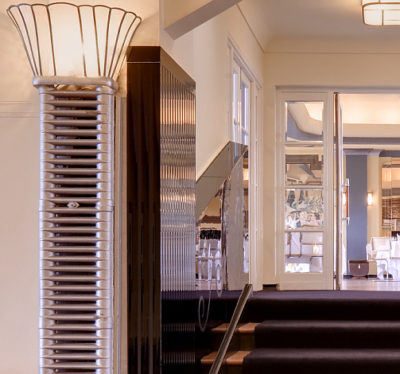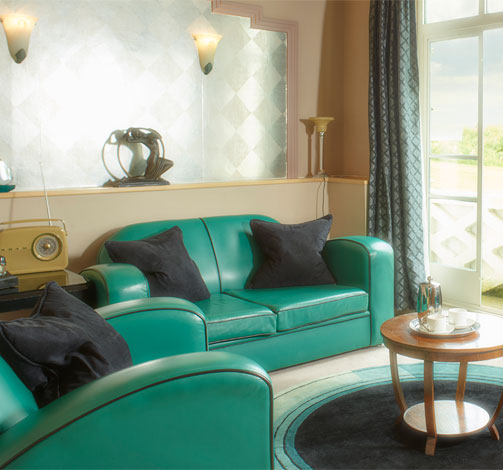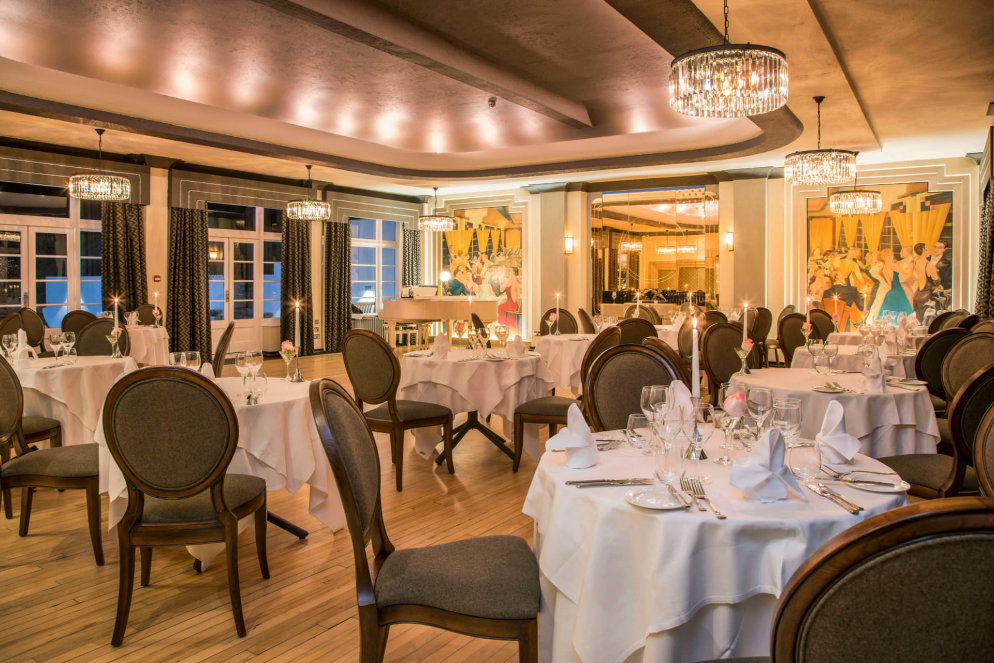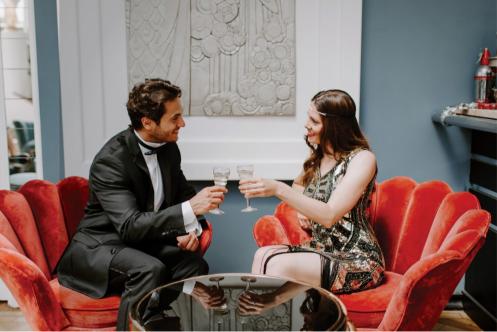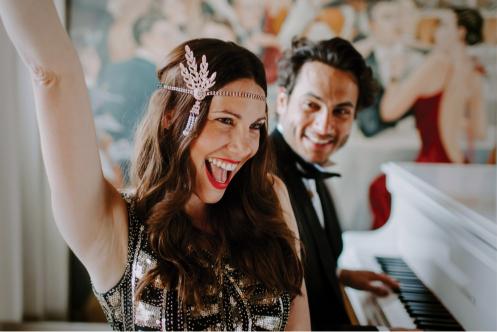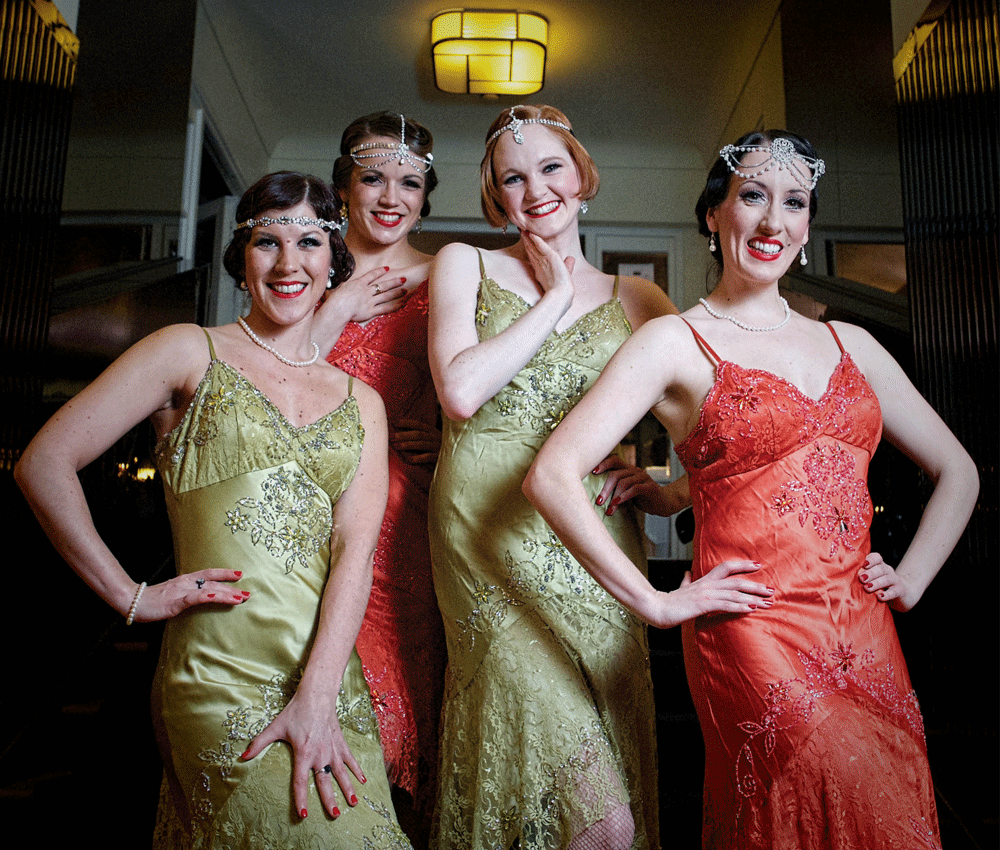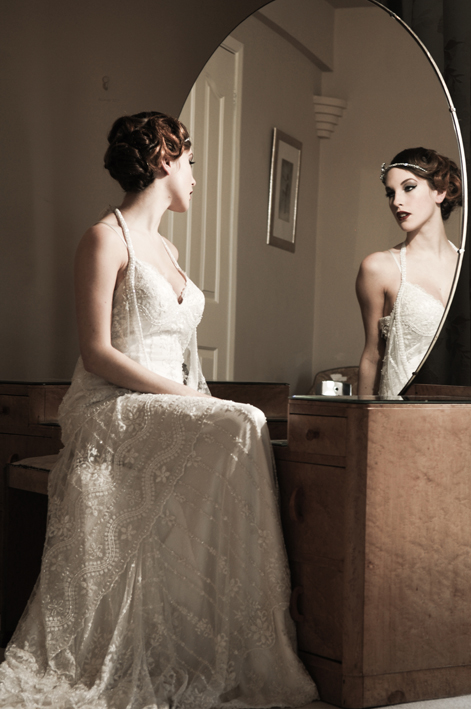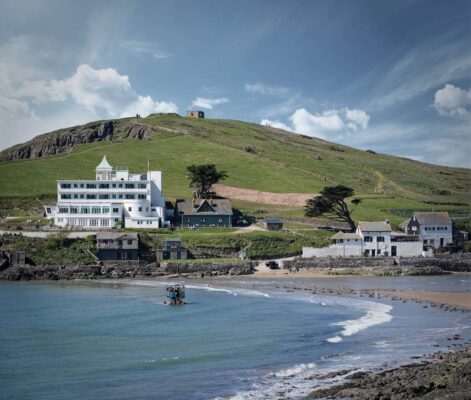The 1920s were a time of great social influence. A time of roaring parties, tall glasses of something strong, and fantastic attire! When Art Deco fashion was born, it quickly became an iconic and glamorous style characterised by its sleek, geometric shapes, bold colours, and luxurious materials. At Burgh Island, Art Deco fashion, architecture and influence is something incredibly close to our hearts. Below, we’re going to discuss the magic of Art Deco fashion in much more detail…
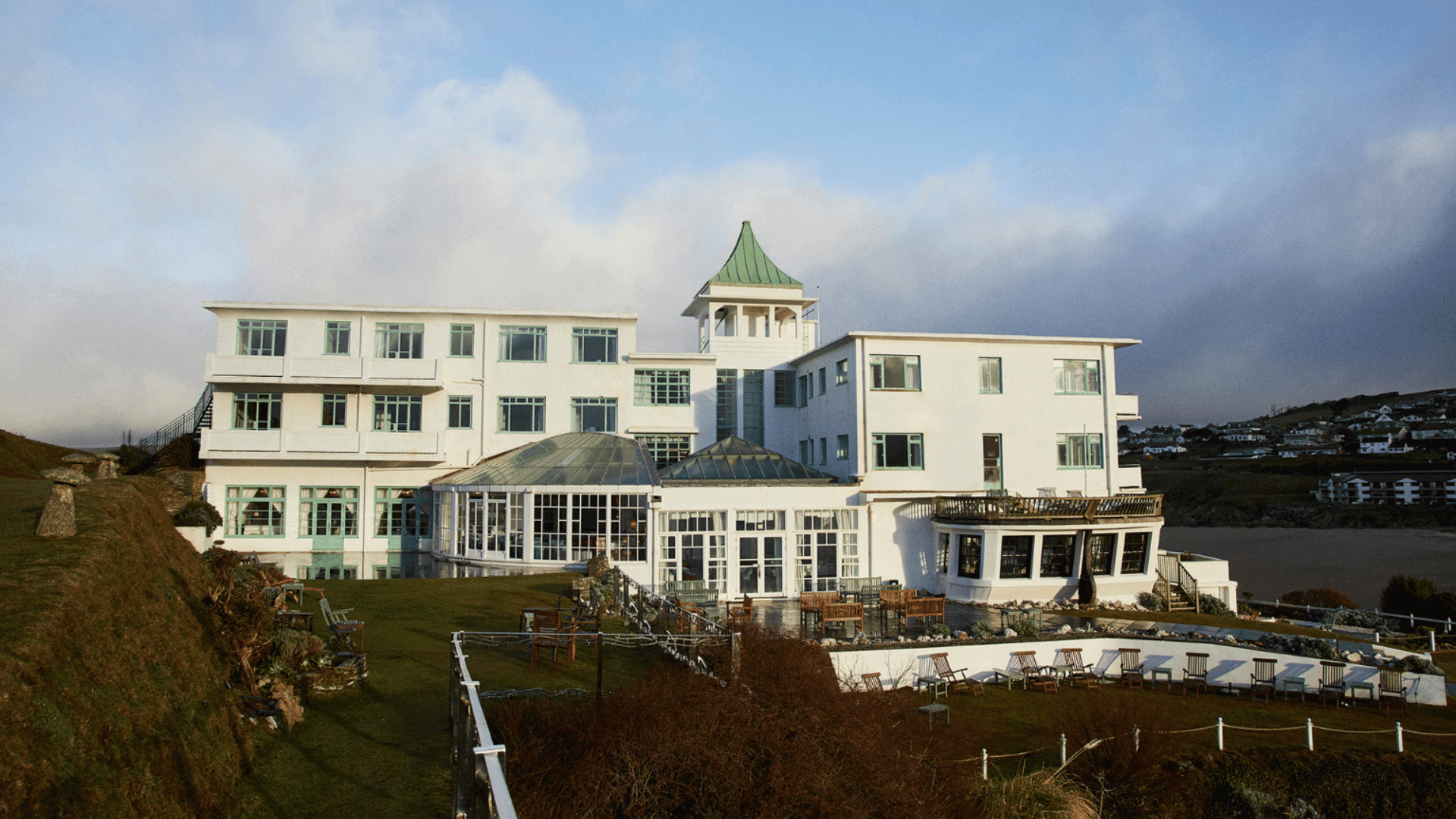
Art Deco Fashion Inspiration
The history of Art Deco
Art Deco certainly reigned supreme in the 1920s and 1930s. Its sleek geometric forms, bold colours and luxurious materials exuded an air of sophistication and modernity that perfectly captured the era’s zeitgeist. While the official name “Art Deco” came later, the seeds of the style were sown before World War I. Movements like Art Nouveau, Cubism, and Futurism were already experimenting with geometric shapes, bold colours, and unconventional forms. After the devastation of the war, Europe craved a fresh start. Paris, the cultural capital, became the breeding ground for a new aesthetic. Designers like Emile-Jacques Ruhlmann and Paul Poiret embraced modern materials like chrome and glass, creating sleek and functional furniture and fashion.
The 1925 Exposition Internationale des Arts Décoratifs et Industriels Modernes in Paris served as Art Deco’s official coming-out party. This world fair showcased the latest in decorative arts, architecture, and design, all infused with the Art Deco spirit. As a result, the world was captivated by the glamour and modernity of Art Deco. The style quickly spread across Europe and the United States, adopted by architects, designers, and artists alike. Skyscrapers like the Chrysler Building in New York and ocean liners like the Queen Mary became stunning testaments to Art Deco’s grandeur, along with the magical Burgh Island Hotel.
Art Deco fashion history
Art Deco fashion was not just a passing trend, it was a movement that reflected the cultural and social changes of the 1920s. The style emerged in Paris in the early 1900s and quickly spread throughout Europe and America. Art Deco fashion was a response to the conservatism of the past, and it embraced a more modern and liberated way of thinking.
The style was heavily influenced by the Art Deco movement, which was characterised by its sleek and geometric shapes, bold colours, and use of luxurious materials. The movement itself was inspired by the technological advancements of the time, and it sought to reflect the new and exciting possibilities of the modern world. Which of course, was mimicked by the fashion.
Art Deco fashion was also heavily influenced by the flapper culture, which was a rebellion against the traditional gender roles of the past! Flappers cut their hair short, wore shorter skirts, and embraced fashion that allowed them to move more freely – shaking off previous notions of womanly dress and conservative attire. This new attitude towards fashion was reflected in Art Deco fashion, which was designed to be both glamorous and practical, a reflection of the social and cultural changes of the time. It was a movement that celebrated excess, glamour, and liberation, and it continues to influence fashion designers and enthusiasts to this day.
Elements of Art Deco Fashion
Art Deco fashion was all about opulence and luxury, and it was characterised by its sleek, geometric shapes, bold colours, and use of high-quality materials. From beaded dresses to shimmering gowns, Art Deco fashion was all about the details. Some of the key elements of Art Deco fashion included beading, sequins, fur, feathers, and metallics. Graphic patterns and bold motifs were also popular, adding a touch of drama and sophistication to any outfit.
When it came to accessories, Art Deco fashion did not disappoint. Beaded handbags, feathered hats, long gloves, and statement jewellery were all popular choices. These accessories added a touch of glamour and sophistication to any outfit, making it the perfect choice for special occasions and red carpet events where opulence and extravagance were desired.
Overall, Art Deco fashion was all about the details. It was designed to make a statement, with bold colours and luxurious materials creating a sense of excess and opulence that truly characterised the Art Deco movement. Even today, the Art Deco aesthetic continues to inspire designers and fashion lovers, making it a timeless style that never goes out of fashion – especially on Burgh Island.
Fashion Icons and Influencers
Art Deco fashion was heavily influenced by Hollywood stars, socialites and fashion designers, who embraced the luxurious and opulent style. Coco Chanel was one of the most influential fashion icons of the era, known for her sleek and minimalist designs. She revolutionised women’s fashion with her elegant and practical designs, such as the little black dress, which quickly became a timeless classic.
Josephine Baker was another influential figure in the Art Deco fashion world, known for her daring and provocative style. She was often seen in shimmering gowns, beaded dresses and elaborate headpieces, which added a touch of drama and sophistication to her performances. Louise Brooks was also a notable fashion icon of the era, with her signature bob haircut and sleek and elegant style. She was often seen in tailored suits and simple yet stylish dresses, which epitomised the Art Deco aesthetic.
Jean Patou was another influential fashion designer known for his bold colours, geometric patterns, and playful details, Patou injected a dose of fun and whimsy into Art Deco fashion. He experimented with new fabrics like cellophane and jersey, creating fluid, dynamic garments that moved with the wearer. Additionally, Patou was a pioneer of sportswear, blurring the lines between casual and chic. His innovative tennis dresses and beachwear featured geometric prints and sleek cuts, making activewear fashionable and desirable. This influence is evident in the rise of athleisure and the fusion of comfort and style in contemporary fashion.
Another Art Deco icon was Elsa Schiaparelli. Schiaparelli refused to follow the rules, injecting surrealist elements into her designs. Lobster prints, tear-shaped buttons, and trompe l’oeil techniques created fantastical pieces that pushed the boundaries of fashion.
Schiaparelli is also credited with creating the iconic “shocking pink” shade, a vibrant fuchsia that became her signature. Her fearless use of colour and unconventional materials continues to inspire designers who don’t shy away from boldness.
Art Deco day and evening wear
Art Deco fashion was all about glamour and luxury, and this was reflected in the day and evening wear of the era. During the day, women wore tailored suits, dresses, and skirts that were designed to be both practical and stylish. The style was characterised by sleek and geometric shapes, bold colours, and luxurious materials. Think about flowing fabrics, like silk and satin, combined with bold graphic patterns and metallic accents. In the evening, the glamour was turned up a notch, with shimmering gowns, beaded dresses, and luxurious fabrics taking centre stage. Art Deco evening wear was all about making a statement, with dramatic silhouettes and intricate beading and embroidery. Accessories played a key role in the style, with statement jewellery, beaded handbags, and feathered hats adding a touch of sophistication and glamour to any outfit.
Art Deco fashion was designed to be worn on special occasions, and it was a celebration of excess and opulence. Even today, the Art Deco aesthetic continues to inspire designers and fashion lovers around the world, making it a timeless style that truly never goes out of fashion and continues to influence and inspire.
Art Deco fashion accessories
Accessories are a huge part of Art Deco fashion and statement jewellery was a key element with oversized necklaces, bold bracelets and chandelier earrings being a popular choice. These accessories were often made with precious materials such as diamonds, rubies and emeralds, adding to the luxurious feel of the style. Bold shapes were another common sight, Forget dainty florals and delicate curves. Art Deco jewellery embraced bold geometric shapes like pyramids, triangles, and circles. Think chunky, angular bangles, statement rings with geometric bezels and earrings that resembled miniature skyscrapers. As for the necklaces of the time, they were no longer simply delicate chains. Chunky statement necklaces featuring geometric pendants or cascading beads were all the rage. Brooches, too became bolder, often featuring stylized animal motifs or stylized floral designs.
Art Deco fashion in modern day
Art Deco fashion may have originated in the 1920s, but its influence is still felt in modern day fashion. From high-end couture to street style, many modern designers have incorporated elements of the Art Deco aesthetic into their collections, whether it be through graphic patterns, metallic accents, or luxurious fabrics. Art Deco-inspired jewellery and accessories are also a popular choice, adding a touch of glamour and sophistication to any outfit.
In addition to fashion, the Art Deco style has also had an impact on interior design, architecture, and art. The iconic buildings of the era, such as the Chrysler Building in New York and the Burj Al Arab in Dubai, continue to inspire awe and admiration with their sleek and elegant designs. Of course, on Burgh Island, we welcome Art Deco-inspired fashions, garments, accessories (and anything else for that matter) to celebrate such a striking movement.
Art Deco Hotel Devon
If you’re a true Art Deco enthusiast, then you simply cannot miss the magic of Burgh Island Hotel. Located on a small island off the coast of Devon, this iconic hotel is a true Art Deco gem, allowing you to step back in time and experience for yourself the wonders of such a captivating era in a striking location. The hotel was built in the 1920s, during the height of the Art Deco movement, and it has retained its stunning Art Deco features ever since. From the moment you step inside, you’re transported back in time to the glamour and excess of the 1920s. The hotel is filled with Art Deco details, from the sleek and geometric shapes of the furniture to the bold and opulent colours of the decor, especially in the soothing blue, Palm Court Lounge bar.
Burgh Island has even been used as a location for several films and television shows, including Agatha Christie’s Poirot and the 2015 adaptation of And Then There Were None, with Christie herself having resided on the island in her very own writer’s retreat, now available for bookings for your very own romantic literary escape. It’s not just the decor that makes Burgh Island Hotel so special, however. The hotel’s location is simply stunning, with breathtaking views of the Devon coastline and the surrounding countryside. The island itself is a peaceful and tranquil oasis, perfect for those looking to escape the hustle and bustle of everyday life.
On the island, you’ll find fantastic amenities, truly spectacular coastal views and access to some incredible restaurants, such as the Nettlefold, The Pilchard Inn and The Grand Ballroom. Whether you’re looking to experience Art Deco in all its majesty or simply looking for a unique hotel stay in the UK, Burgh Island is the perfect place for you.
